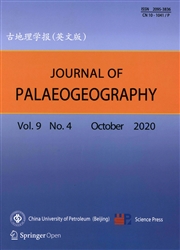Thickening-upward cycles in deep-marine and deep-lacustrine turbidite lobes:examples from the Clare Basin and the Ordos Basin
作者:Lei-Fu Zhang,Da-Zhong Dong
摘要:Deep-marine and deep-lacustrine reservoirs have been targets for conventional and unconventional oil and gas exploration and development for decades. Thickening-upward cycles in the deep-marine Carboniferous Ross Sandstone Formation outcrops in western Ireland and the deep-lacustrine Triassic Yanchang Formation outcrops in southeast Ordos Basin have been investigated and correlated in this study. Typical thickening-upward cycles consisting of, from bottom to top:(1) laminated shales/shales with interbedded siltstone beds;(2) interbedded sandstones/siltstones and mudstones;(3) structureless massive sandstones, are well recognized in these outcrops and are interpreted as turbidite lobes. A continuously prograding lobe-element model is proposed to explain the repeated stacking of thickening-upward cycles. Thickening-upward cycles developed within deep-marine and deeplacustrine environments are highly comparable in many aspects, such as sedimentary structures, sheet-like geometries and amalgamation features. A frequent and strong degree of amalgamation is developed within the massive sandstone at the top of each thickening-upward cycle, suggesting a layer-by-layer depositional manner.Field observations and comparison with deep-marine counterparts support the occurrence of turbidity flows in the Yanchang Formation, Ordos Basin.
发文机构:PetroChina Research Institute of Petroleum Exploration and Development School of Geological Sciences National Energy Shale Gas Research(Experiment)Center CNPC Key Laboratory of Unconventional Oil and Gas
关键词:Thickening-upwardcycleDeep-marineturbiditeDeep-lacustrineturbiditeYangchangFormationOrdosBasinKilbahaBay
分类号: P618.12[天文地球—矿床学]P512.2[天文地球—地质学]
- Genus Pronephrium Presl 1851 (Thelypteridaceae) in Romania
- Ancient rip current records and their implications: an example from the Cretaceous Ukra Member, Kutch, India
- New freshwater plesiosaurian materials from the Middle Jurassic Xintiangou Formation of the Sichuan Basin, southwestern China
- First steps in reconstructing Early Jurassic sea water temperatures in the Andean Basin of northern Chile based on stable isotope analyses of oyster and brachiopod shells
- A facies and palaeogeography-based approach for analysis of petroleum systems in United Arab Emirates
- The complexity of climate reconstructions using the coexistence approach on Qinghai-Tibetan Plateau
- The use of mineral interfaces in sand-sized volcanic rock fragments to infer mechanical durability
- Fruits of Scirpus (Cyperaceae) from the early Miocene of Weichang,Hebei Province, North China and their palaeoecological and palaeobiogeographical implications
- Words of the Editor-in-Chief——some ideas about the comments and discussions of hyperpycnal flows and hyperpycnites
- Summary of Editorial Committee Meeting (January 5, 2020) of Journal of Palaeogeography


